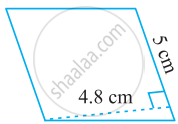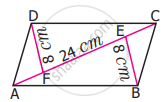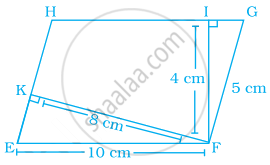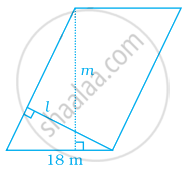Advertisements
Advertisements
प्रश्न
ABCD is a parallelogram in which AE is perpendicular to CD as shown in the given figure. Also, AC = 5 cm, DE = 4 cm and area of ΔAED = 6 cm2. Find the perimeter and area of parallelogram ABCD.
उत्तर
Given area of ΔAED = 6 cm2 and AC = 5 cm and DE = 4 cm
∴ Area of ΔAED = `1/2` × DE × AE ......[∵ Area of triangle = Base × Height]
⇒ `1/2` × 4 × AE = 6
⇒ AE = `(6 xx 2)/4`
⇒ AE = 3 cm
Now, In right-angled ΔAEC, AE = 3 cm and AC = 5 cm
So, = (EC)2 = (AC)2 – (AE)2 ......[By Pythagoras theorem]
⇒ (EC)2 = 52 – 32 = 25 – 9
⇒ EC = `sqrt(16)`
⇒ EC = 4 cm
∵ DE + EC = DC
⇒ DC = 4 + 4 = 8 cm
∵ ABCD is a parallelogram
So, AB = DC = 8 cm
Now, In right-angled ΔAED, AD2 = AE2 + ED2 ......[By Pythagoras theorem]
⇒ AD2 = 32 + 42 = 9 + 16
⇒ AD = `sqrt(25)`
⇒ AD = 5 cm
So, AD = BC = 5 cm ......[∵ ABCD is a parallelogram]
∴ Perimeter of paralielogram ABCD = 2(l + b) = 2(DC + AD) = 2(8 + 5) = 2 × 13 = 26 cm
Area of parallelogram ABCD = Base × Height = DC × AE = 8 × 3 = 24 cm.
APPEARS IN
संबंधित प्रश्न
Find the area of the following parallelogram:

If base of a parallelogram is 18 cm and its height is 11 cm, find its area.
If area of a parallelogram is 29.6 sq cm and its base is 8 cm, find its height.
A parallelogram has sides of 15 cm and 12 cm; if the distance between the 15 cm sides is 6 cm; find the distance between 12 cm sides.
A ground is in the shape of parallelogram. The height of the parallelogram is 14 metres and the corresponding base is 8 metres longer than its height. Find the cost of levelling the ground at the rate of ₹ 15 per sq.m
Find the area of the parallelogram ABCD if AC is 24 cm and BE = DF = 8 cm
Find the missing value:
| Base | Height | Area of parallelogram |
| 15.6 cm | ______ | 16.38 cm2 |
In the given figure, EFGH is a parallelogram, altitudes FK and FI are 8 cm and 4 cm respectively. If EF = 10 cm, then area of EFGH is ______.

In the given figure, find the area of parallelogram ABCD, if the area of shaded triangle is 9 cm2.

Perimeter of a parallelogram shaped land is 96 m and its area is 270 square metres. If one of the sides of this parallelogram is 18 m, find the length of the other side. Also, find the lengths of altitudes l and m in the given figure.

